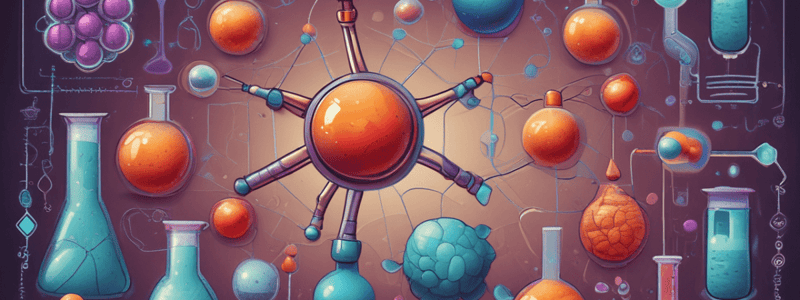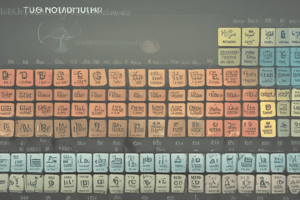Podcast
Questions and Answers
What is the composition of an atom that determines its electrical charge?
What is the composition of an atom that determines its electrical charge?
The equal number of protons and electrons
What is the term for the building blocks of matter that are essential for human nutrition?
What is the term for the building blocks of matter that are essential for human nutrition?
Elements
What type of bond forms between atoms when they share electrons?
What type of bond forms between atoms when they share electrons?
Chemical bond
What is the term for atoms or groups of atoms that gain or lose electrons, resulting in an electrical charge?
What is the term for atoms or groups of atoms that gain or lose electrons, resulting in an electrical charge?
What is the purpose of the pH scale?
What is the purpose of the pH scale?
What type of reaction involves changes in the arrangement of atoms in molecules?
What type of reaction involves changes in the arrangement of atoms in molecules?
What is the role of enzymes in chemical reactions?
What is the role of enzymes in chemical reactions?
What is the term for a mixture of two or more compounds, with water often being the solvent?
What is the term for a mixture of two or more compounds, with water often being the solvent?
Flashcards are hidden until you start studying
Study Notes
Matter and Atoms
- Matter is composed of atoms that contain protons and electrons.
- Atoms have no electrical charge due to the equal number of protons and electrons.
- There are over 100 different types of atoms, each with its own element.
Elements
- Elements are the building blocks of matter and are essential for human nutrition.
- Examples of nutrition-related elements include Hydrogen (H), Oxygen (O), Carbon (C), Nitrogen (N), Calcium (Ca), and Iron (Fe).
Molecules and Compounds
- Molecules form when atoms interact and share electrons, forming a chemical bond.
- Chemical formulas represent the number and type of atoms in a molecule.
- Compounds are molecules that contain two or more different elements in specific proportions.
- Solutions are evenly distributed mixtures of two or more compounds, with water often being the solvent.
Ions
- Ions are atoms or groups of atoms that gain or lose electrons, resulting in an electrical charge.
- Ions can be positively charged (e.g., ammonium ion) or negatively charged (e.g., hydroxide ion).
- Electrolytes, such as sodium and potassium, are ions that conduct electricity and have important functions in the body.
Acids and Bases
- Acids are substances that lose H+ when dissolved in water.
- Bases are substances that remove and accept H+ when dissolved in water.
- pH measures the concentration of hydrogen ions in a solution, with a pH of 7 being neutral.
- The pH scale ranges from 0 to 14, with low values indicating high acidity and high values indicating high basicity.
Chemical Reactions
- Chemical reactions involve changes in the arrangement of atoms in molecules.
- Synthetic reactions combine elements or compounds to form new substances.
- Decomposition reactions break down molecules into smaller components.
- Enzymes are molecules (usually proteins) that catalyze specific chemical reactions.
Enzymes
- Enzymes speed up chemical reactions without becoming part of the products.
- Enzymes have specific actions and are sensitive to environmental conditions such as pH, temperature, and presence of vitamins and minerals.
- Examples of enzymes include sucrase, which breaks down sucrose into glucose and fructose.
Metabolism
- Metabolism refers to the sum of all chemical reactions that occur in living cells.
- Catabolic reactions involve breaking down molecules, while anabolic reactions involve synthesizing new compounds.
Studying That Suits You
Use AI to generate personalized quizzes and flashcards to suit your learning preferences.




